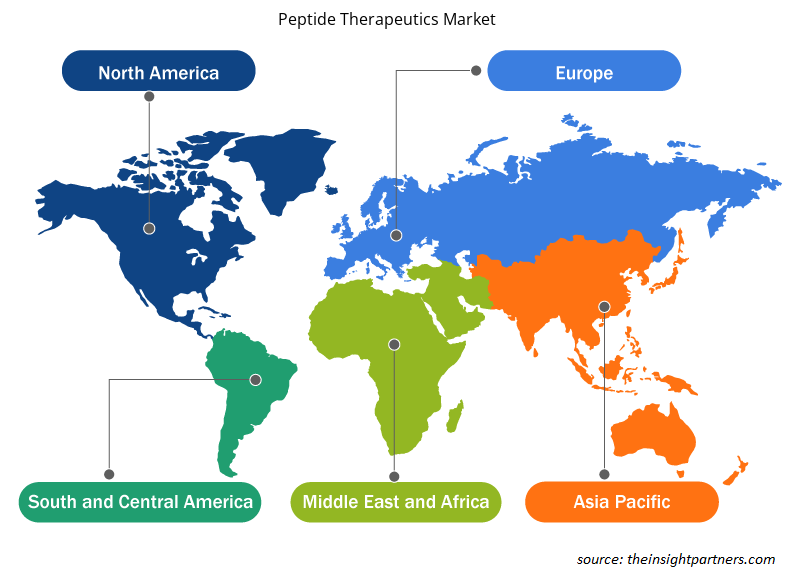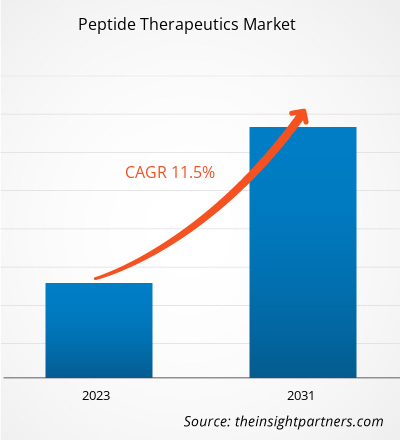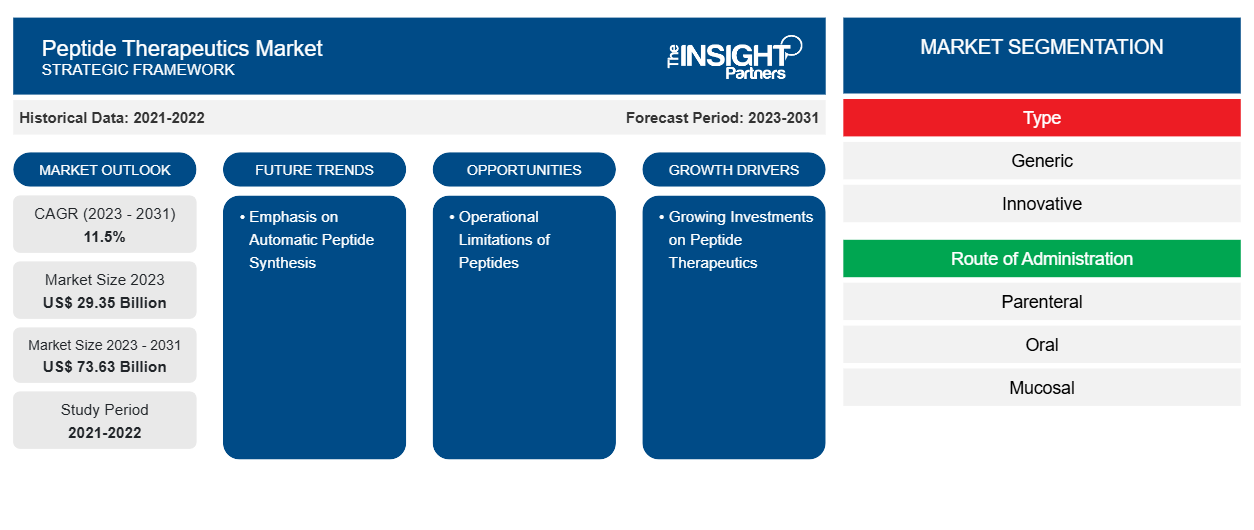Der Markt für Peptidtherapeutika soll von 29,35 Milliarden US-Dollar im Jahr 2023 auf 73,63 Milliarden US-Dollar im Jahr 2031 anwachsen. Der Markt wird voraussichtlich zwischen 2023 und 2031 eine durchschnittliche jährliche Wachstumsrate (CAGR) von 11,5 % verzeichnen. Die zunehmende Popularität, die das Tempo der Herstellung von Peptidmedikamenten verringert, und die Einführung neuer Technologien werden voraussichtlich weiterhin die wichtigsten Trends auf dem Markt für Peptidtherapeutika bleiben.
Marktanalyse für Peptidtherapeutika
Da die globale Belastung durch chronische Krankheiten zunimmt, steigt die Nachfrage nach gezielten und effizienten Therapieansätzen. Mit ihrer Präzision und Spezifität erweisen sich Peptidtherapeutika als überzeugende Lösung, die den therapeutischen Anforderungen verschiedener chronischer Krankheiten gerecht wird. Robuste Forschungspipelines versprechen eine Zukunft voller neuartiger und bahnbrechender Peptidtherapeutika. Der Trend hin zur personalisierten Medizin steht im Einklang mit den einzigartigen Eigenschaften der Peptidtherapeutika. Da Peptide bei der Behandlung seltener Krankheiten vielversprechend sind, konzentrieren sich Pharmaunternehmen auf die Entwicklung therapeutischer Lösungen für Nischenpatientengruppen. Innovationen bei synthetischen Methoden führen zu komplexeren und spezialisierteren Peptiden und erweitern das therapeutische Arsenal, das den Angehörigen von Gesundheitsberufen zur Verfügung steht. Darüber hinaus treiben gemeinsame Anstrengungen in Forschungsinitiativen zwischen Wissenschaftlern und Marktteilnehmern Innovationen auf dem Markt für Peptidtherapeutika voran. Darüber hinaus schaffen Partnerschaften und Allianzen Synergien, die die Entwicklung hochmoderner peptidbasierter Therapien vorantreiben. Strenge Vorschriften und hohe Kosten für die Arzneimittelentwicklung dürften jedoch das Marktwachstum bremsen.
Marktübersicht für Peptidtherapeutika
Der Markt für Peptidtherapeutika entwickelt sich zu einem dynamischen und vielversprechenden Sektor innerhalb der Pharmaindustrie und bietet einen einzigartigen Ansatz zur Behandlung verschiedener Krankheiten und Beschwerden. Peptidtherapeutika, die aus kurzen Aminosäuresequenzen bestehen, haben aufgrund ihrer Spezifität, Wirksamkeit und potenziellen Anwendungen in verschiedenen therapeutischen Bereichen beträchtliche Aufmerksamkeit auf sich gezogen. Dieser aufstrebende Markt steht an der Schnittstelle zwischen Innovation und Medizinwissenschaft und ist bereit, die Gesundheitslandschaft neu zu gestalten. Der Markt umfasst verschiedene Peptide, von natürlich vorkommenden bis hin zu synthetischen Analoga, die für verbesserte therapeutische Ergebnisse entwickelt wurden. Diese Peptide sind vielseitige Wirkstoffe, die auf bestimmte Rezeptoren, Enzyme oder zelluläre Mechanismen abzielen, was sie zu einem wertvollen Instrument der Präzisionsmedizin macht.
Passen Sie diesen Bericht Ihren Anforderungen an
Sie erhalten kostenlos individuelle Anpassungen an jedem Bericht, einschließlich Teilen dieses Berichts oder einer Analyse auf Länderebene, eines Excel-Datenpakets sowie tolle Angebote und Rabatte für Start-ups und Universitäten.
- Holen Sie sich die wichtigsten Markttrends aus diesem Bericht.Dieses KOSTENLOSE Beispiel umfasst eine Datenanalyse von Markttrends bis hin zu Schätzungen und Prognosen.
Treiber und Chancen auf dem Markt für Peptidtherapeutika
Zunehmende Prävalenz von Stoffwechselstörungen und Infektionskrankheiten begünstigt den Markt
Laut einem Artikel in der National Library of Medicine sind Infektionskrankheiten weltweit nach wie vor eine der Hauptursachen für Krankheit und Tod und verursachen weltweit mehr als 52 Millionen Todesfälle pro Jahr. Nach Angaben der IDF vom Dezember 2021 leiden in Mexiko schätzungsweise 14 Millionen Erwachsene an Diabetes. Peptide wie Amid (GLP-1) sind bei der Behandlung von Diabetes wirksam. Im Februar 2022 berichtete die Provinzregierung von Nova Scotia, dass sich die Einwohner von Nova Scotia in Pharmacare-Programmen registriert haben, die mit der Umstellung auf eine Biosimilar-Version bestimmter biologischer Arzneimittel, darunter einige Insuline und Medikamente, zur Behandlung von Morbus Crohn und Rheuma beginnen sollen. Die zunehmenden Fälle einiger Stoffwechselstörungen wie Organfunktionsstörungen, genetische Störungen und mitochondriale Dysfunktion sind einer der Faktoren, die das Marktwachstum vorantreiben. Die fortschreitende Speicherung von Glukozerebrosiden in Makrophagen, vor allem in Knochen, Knochenmark, Milz und Leber, sind Anzeichen für die Gaucher-Krankheit (GD), eine autosomal-rezessive lysosomale Speicherkrankheit. Laut dem Journal of Pediatric Haematology/Oncology (JPHO) betrug die Prävalenz von GD-Fällen pro 100.000 Lebendgeburten weltweit im Juli 2022 1,5. Daher treibt die hohe Prävalenz von Infektions- und Stoffwechselkrankheiten die Nachfrage nach Peptidtherapeutika zur Behandlung dieser Krankheiten an und fördert so das Marktwachstum.IDF published in December 2021, an estimated 14 million adults in Mexico have diabetes. Peptides such as amide (GLP-1) are effective in treating diabetes. In February 2022, the Nova Scotia provincial government reported that Nova Scotians have registered in pharmacare programs that would begin switching to a biosimilar version of certain biologic medicines, including some insulins and medications, for the treatment of Crohn's disease and rheumatism. The increasing cases of some metabolic disorders, such as organ dysfunction, genetic disorders, and mitochondrial dysfunction, are one of the factors that drive the market growth. The progressive storage of glucocerebrosides in macrophages, primarily in the bone, bone marrow, spleen, and liver are the indications of Gaucher disease (GD) which is an autosomal recessive lysosomal storage disorder. As per the Journal of Pediatric Haematology/Oncology (JPHO), in July 2022, the prevalence of GD cases per 100,000 live births worldwide was 1.5. Therefore, the high prevalence of infectious and metabolic diseases drives the demand for peptide therapeutics for treating these diseases, thereby boosting market growth.
Starke Pipeline und Anwendungen von Peptidmedikamenten – eine Chance für das Wachstum des Marktes für Peptidtherapeutika
Die häufigsten Indikationen für Peptide sind Onkologie, Endokrinologie und Stoffwechselerkrankungen. Weitere Zielbereiche von Peptiden, die Aufmerksamkeit erhalten haben, sind Gastroenterologie , Herz-Kreislauf-Erkrankungen, Dermatologie, Knochenerkrankungen und sexuelle Funktionsstörungen. Aufgrund ihrer hohen Immunogenität haben Peptidimpfstoffe auch großes Potenzial, eine Alternative zu klassischen Impfstoffen zu werden, da sie vollständig synthetisch sind und keine unerwünschten Nebenwirkungen verursachen. Um ihre Einschränkungen zu überwinden, wurden verschiedene Modifikationen von Peptiden eingeführt. Darüber hinaus wird erwartet, dass die laufenden Studien zur Anwendung von Peptiden die Pipeline positiv beeinflussen und so lukrative Möglichkeiten für Marktwachstum bieten. Einige Peptid-Medikamentenpipelines sind wie folgt:immunogenicity, peptide vaccines also have great potential to become an alternative to classical vaccines as they are completely synthetic and do not cause undesirable side effects. To overcome their limitations, various modifications of peptides have been introduced. Furthermore, the ongoing studies related to the application of peptides are expected to positively impact the pipeline, thereby providing lucrative opportunities for market growth. Some peptide drug pipelines are as follows:
Unternehmen | Peptid | Therapiebereich | Entwicklungsstadium |
3B Pharmaceuticals (Deutschland) | FAP-2286 | Onkologie-FAP-exprimierende Tumoren | Klinische Studien der Phase I |
3B 401 | Neuroendokrine Tumoren | Präklinische Studien | |
Allysta Pharmaceuticals (USA) | ALY688 | Augenheilkunde – Trockenes Auge | Klinische Studien der Phase II |
ALY688SR | Lebererkrankungen und Fettleibigkeit | Klinische Studien der Phase I |
Quelle: Issar Pharma, Willing Wellness
Segmentierungsanalyse des Marktberichts für Peptidtherapeutika
Wichtige Segmente, die zur Ableitung der Marktanalyse für Peptidtherapeutika beigetragen haben, sind Komponente, Anwendung und Endbenutzer.
- Basierend auf dem Typ wird der Markt für Peptidtherapeutika in generische und innovative unterteilt. Das innovative Segment hielt im Jahr 2023 den größten Marktanteil, während das generische Segment im Prognosezeitraum voraussichtlich die höchste durchschnittliche jährliche Wachstumsrate verzeichnen wird.
- Nach Verabreichungsweg ist der Markt in parenteral, oral, mukosal, pulmonal und andere unterteilt. Das parenterale Segment hatte 2023 den größten Marktanteil, und das orale Segment dürfte zwischen 2023 und 2031 die höchste durchschnittliche jährliche Wachstumsrate verzeichnen.
- Basierend auf der Synthesetechnologie ist der Markt für Peptidtherapeutika in Festphasenpeptidsynthese (SPPS), Flüssigphasenpeptidsynthese (LPPS) und Hybridtechnologie unterteilt. Das Segment der Festphasenpeptidsynthese hatte im Jahr 2023 den größten Marktanteil. Es wird jedoch erwartet, dass das Segment der Hybridtechnologie im Prognosezeitraum die höchste durchschnittliche jährliche Wachstumsrate verzeichnet.
- In Bezug auf die Anwendung ist der Markt in Krebs, Herz-Kreislauf-Erkrankungen, Stoffwechselstörungen, Atemwegserkrankungen , Schmerzen und Dermatologie unterteilt. Das Krebssegment hatte 2023 den größten Marktanteil. Es wird jedoch geschätzt, dass das Segment Stoffwechselstörungen zwischen 2023 und 2031 die höchste durchschnittliche jährliche Wachstumsrate verzeichnet.
Marktanteilsanalyse für Peptidtherapeutika nach geografischer Lage
Der geografische Umfang des Marktberichts für Peptidtherapeutika ist hauptsächlich in fünf Regionen unterteilt: Nordamerika, Asien-Pazifik, Europa, Naher Osten und Afrika sowie Südamerika/Süd- und Mittelamerika.
Nordamerika dominiert den Markt für Peptidtherapeutika. Das Wachstum des nordamerikanischen Marktes ist auf die renommierten akademischen Institutionen und hochmodernen Labors zurückzuführen. Die Zusammenarbeit zwischen Wissenschaft und Industrie trägt zu einem lebendigen F&E-Ökosystem bei, das die Entdeckung und Entwicklung neuer Peptide mit therapeutischem Potenzial fördert. In Nordamerika spielt der Biotechnologiesektor eine wichtige Rolle bei der Entwicklung von Peptidtherapeutika. Die Präsenz führender Biotechnologieunternehmen und ein unterstützendes regulatorisches Umfeld fördern die Umsetzung von Forschungsergebnissen in klinisch tragfähige Peptid-basierte Behandlungen und positionieren Nordamerika als führenden Anbieter im globalen Bereich der Peptidtherapeutika. Die Prävalenz chronischer Krankheiten in Nordamerika unterstreicht den Bedarf an fortschrittlichen therapeutischen Lösungen. Mit ihren gezielten Wirkmechanismen erweisen sich Peptidtherapeutika als vielversprechende Kandidaten für die Behandlung von Krankheiten wie Diabetes, Herz-Kreislauf-Erkrankungen (CVDs) und verschiedenen Krebsarten. Der asiatisch-pazifische Raum wird in den kommenden Jahren voraussichtlich die höchste durchschnittliche jährliche Wachstumsrate aufweisen.
Regionale Einblicke in den Markt für Peptidtherapeutika
Die regionalen Trends und Faktoren, die den Markt für Peptidtherapeutika im Prognosezeitraum beeinflussen, wurden von den Analysten von Insight Partners ausführlich erläutert. In diesem Abschnitt werden auch die Marktsegmente und die Geografie von Peptidtherapeutika in Nordamerika, Europa, im asiatisch-pazifischen Raum, im Nahen Osten und Afrika sowie in Süd- und Mittelamerika erörtert.

- Erhalten Sie regionale Daten zum Markt für Peptidtherapeutika
Umfang des Marktberichts über Peptidtherapeutika
| Berichtsattribut | Details |
|---|---|
| Marktgröße im Jahr 2023 | 29,35 Milliarden US-Dollar |
| Marktgröße bis 2031 | 73,63 Milliarden US-Dollar |
| Globale CAGR (2023 - 2031) | 11,5 % |
| Historische Daten | 2021-2022 |
| Prognosezeitraum | 2023–2031 |
| Abgedeckte Segmente | Nach Typ
|
| Abgedeckte Regionen und Länder | Nordamerika
|
| Marktführer und wichtige Unternehmensprofile |
|
Marktteilnehmerdichte: Der Einfluss auf die Geschäftsdynamik
Der Markt für Peptidtherapeutika wächst rasant, angetrieben durch die steigende Nachfrage der Endverbraucher aufgrund von Faktoren wie sich entwickelnden Verbraucherpräferenzen, technologischen Fortschritten und einem größeren Bewusstsein für die Vorteile des Produkts. Mit steigender Nachfrage erweitern Unternehmen ihr Angebot, entwickeln Innovationen, um die Bedürfnisse der Verbraucher zu erfüllen, und nutzen neue Trends, was das Marktwachstum weiter ankurbelt.
Die Marktteilnehmerdichte bezieht sich auf die Verteilung der Firmen oder Unternehmen, die in einem bestimmten Markt oder einer bestimmten Branche tätig sind. Sie gibt an, wie viele Wettbewerber (Marktteilnehmer) in einem bestimmten Marktraum im Verhältnis zu seiner Größe oder seinem gesamten Marktwert präsent sind.
Die wichtigsten auf dem Markt für Peptidtherapeutika tätigen Unternehmen sind:
- Eli Lilly und Company,
- Amgen Inc.,
- Teva Pharmaceutical Industries Ltd.,
- Lonza,
- Sanofi,
- Bristol-Myers Squibb Company,
Haftungsausschluss : Die oben aufgeführten Unternehmen sind nicht in einer bestimmten Reihenfolge aufgeführt.

- Erhalten Sie einen Überblick über die wichtigsten Akteure auf dem Markt für Peptidtherapeutika
Nachrichten und aktuelle Entwicklungen zum Markt für Peptidtherapeutika
Der Markt für Peptidtherapeutika wird durch die Erhebung qualitativer und quantitativer Daten aus Primär- und Sekundärforschung bewertet, die wichtige Unternehmensveröffentlichungen, Verbandsdaten und Datenbanken einschließen. Im Folgenden finden Sie eine Liste der Entwicklungen auf dem Markt für Peptidtherapeutika:
- Novo Nordisk gab bekannt, dass die US-amerikanische Food and Drug Administration (FDA) eine zusätzliche Indikation für Wegovy genehmigt hat, um das Risiko schwerer kardiovaskulärer Ereignisse wie Tod, Herzinfarkt oder Schlaganfall bei Erwachsenen mit bekannter Herzerkrankung und mit Fettleibigkeit oder Übergewicht zusammen mit einer kalorienreduzierten Ernährung und gesteigerter körperlicher Aktivität zu verringern. (Novo Nordisk A/S, Pressemitteilung, 2024)
- Ono Pharmaceutical Co., Ltd. gab bekannt, dass es eine Kooperationsvereinbarung zur Arzneimittelforschung mit PeptiDream Inc. eingegangen ist, um neuartige makrozyklische Peptid-Medikamente gegen mehrere Zielmoleküle zu erforschen und zu entwickeln. Im Rahmen der Vereinbarung wird PeptiDream makrozyklische Peptid-Medikamentenkandidaten für mehrere von Ono ausgewählte Zielmoleküle identifizieren und optimieren. Dabei wird PeptiDream die proprietäre Peptide Discovery Platform System (PDPS)-Technologie von PeptiDream einsetzen. (Quelle: ONO PHARMACEUTICAL CO., LTD., News, 2023)
- Biosynth, ein Lieferant kritischer Materialien für die Biowissenschaftsbranche, gab die Übernahme von Pepceuticals bekannt, einem britischen Hersteller synthetischer Peptide mit GMP-Anlagen für mehrere Kilogramm und Abfüllkapazitäten, die darauf ausgelegt sind, Kunden von klinischen Studien bis zur kommerziellen Versorgung zu unterstützen. Die Übernahme ermöglicht die Unterstützung aller Phasen des Produktlebenszyklus von der Entdeckung bis zur Vermarktung. (Quelle: Biosynth, News, 2023)
- IRBM, ein innovatives Auftragsforschungsinstitut, gab bekannt, dass es eine neue Vereinbarung mit Merck & Co. Inc. unterzeichnet hat, um die Zusammenarbeit im Bereich der Peptidtherapie fortzusetzen. Die Zusammenarbeit ermöglicht es, IRBMs erstklassige wissenschaftliche Expertise im Bereich Peptiddesign und -synthese mit den außergewöhnlichen Fähigkeiten von Merck & Co. Inc. in der Arzneimittelentwicklung zu kombinieren, wobei der Schwerpunkt auf der Bereitstellung innovativer Therapien für bedürftige Patienten liegt. (Quelle: IRBM SpA; Pressemitteilung; 2023)
- Forscher der Universität Hokkaido haben eine neuartige Methode entwickelt, um Peptidantibiotika in großen Mengen zu entwerfen und zu entwickeln, was sich für die Bekämpfung der Antibiotikaresistenz als entscheidend erweisen wird. (Universität Hokkaido, Pressemitteilung, 2023)
Marktbericht zu Peptidtherapeutika – Abdeckung und Ergebnisse
Der Bericht „Marktgröße und Prognose für Peptidtherapeutika (2021–2031)“ bietet eine detaillierte Analyse des Marktes, die die folgenden Bereiche abdeckt:
- Marktgröße und Prognose auf globaler, regionaler und Länderebene für alle wichtigen Marktsegmente, die im Rahmen des Projekts abgedeckt sind
- Marktdynamik wie Treiber, Beschränkungen und wichtige Chancen
- Wichtige Zukunftstrends
- Detaillierte PEST/Porters Five Forces- und SWOT-Analyse
- Globale und regionale Marktanalyse mit wichtigen Markttrends, wichtigen Akteuren, Vorschriften und aktuellen Marktentwicklungen
- Branchenlandschaft und Wettbewerbsanalyse, einschließlich Marktkonzentration, Heatmap-Analyse, prominenten Akteuren und aktuellen Entwicklungen
- Detaillierte Firmenprofile
- Historische Analyse (2 Jahre), Basisjahr, Prognose (7 Jahre) mit CAGR
- PEST- und SWOT-Analyse
- Marktgröße Wert/Volumen – Global, Regional, Land
- Branchen- und Wettbewerbslandschaft
- Excel-Datensatz
Aktuelle Berichte
Erfahrungsberichte
Grund zum Kauf
- Fundierte Entscheidungsfindung
- Marktdynamik verstehen
- Wettbewerbsanalyse
- Kundeneinblicke
- Marktprognosen
- Risikominimierung
- Strategische Planung
- Investitionsbegründung
- Identifizierung neuer Märkte
- Verbesserung von Marketingstrategien
- Steigerung der Betriebseffizienz
- Anpassung an regulatorische Trends





















 Kostenlose Probe anfordern für - Markt für Peptidtherapeutika
Kostenlose Probe anfordern für - Markt für Peptidtherapeutika